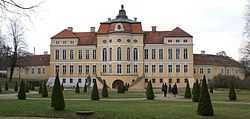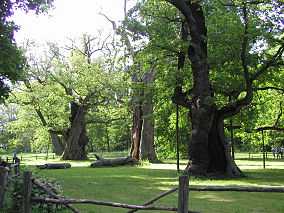Rogalin
| Rogalin | |
|---|---|
| Village | |
 | |
 Rogalin | |
| Coordinates: 52°14′04″N 16°56′04″E / 52.23444°N 16.93444°ECoordinates: 52°14′04″N 16°56′04″E / 52.23444°N 16.93444°E | |
| Country |
|
| Voivodeship | Greater Poland |
| County | Poznań County |
| Gmina | Mosina |
| Population (approx.) | 700 |
Rogalin [rɔˈɡalin] (German: Eichenhain) is a village in western Poland, situated on the Warta river. It lies approximately 7 kilometres (4 mi) east of the town of Mosina, and 19 km (12 mi) south of the city of Poznań.
Rogalin is primarily famous for its 18th-century baroque palace of the Raczyński family, and the adjacent Raczyński Art Gallery, housing a permanent exhibition of Polish and international paintings (including Paul Delaroche and Claude Monet and the famous Jan Matejko's large-scale painting Joanna d'Arc, see a fragment below). The gallery was started by Edward Aleksander Raczyński. Rogalin is also known for its putatively 1000-year-old oak trees (Polish: Dęby Rogalińskie) on the banks of the Warta.
The last owner of the estate was Count Edward Bernard Raczyński, who in 1979–1986 was President of the Polish Republic in exile. His coffin is deposited in the Raczyński Mausoleum, under the historical chapel in Rogalin. In his testament, Count Raczyński bequeathed his family palace in Rogalin and his library to the Polish people.
Much of the surrounding area forms a protected area known as Rogalin Landscape Park.
-
.jpg)
Palace in Rogalin - front view
-
Chapel and Mausoleum of the Raczyński family
-

Statue in Rogalin Park
-

Rogalin Oaks
-

Joanna d`Arc, fragment of large-scale painting by Jan Matejko of 1886
External links
- photos from Rogalin - Adam Wyszynski -*http://rogalin.eu
- rogalin.org - Informations for tourists and citizens.
| ||||||||||

